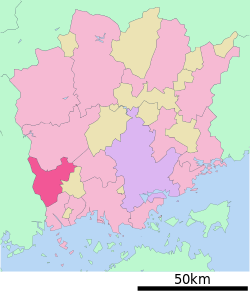Ibara, Okayama
|
Ibara 井原市 |
||
|---|---|---|
| City | ||
|
||
 Location of Ibara in Okayama Prefecture |
||
| Location in Japan | ||
| Coordinates: 34°36′N 133°28′E / 34.600°N 133.467°ECoordinates: 34°36′N 133°28′E / 34.600°N 133.467°E | ||
| Country | Japan | |
| Region | Chūgoku (San'yō) | |
| Prefecture | Okayama Prefecture | |
| Area | ||
| • Total | 243.36 km2 (93.96 sq mi) | |
| Population (2008) | ||
| • Total | 44,271 | |
| • Density | 180/km2 (470/sq mi) | |
| Time zone | Japan Standard Time (UTC+9) | |
| Website | www |
|
Ibara (井原市 Ibara-shi?) is a city located in Okayama Prefecture, Japan. The city was founded on March 30, 1953.
As of 2008[update], the city has an estimated population of 44,271 and a population density of 182 people per km². The total area is 243.36 square kilometres (93.96 square miles).
On March 1, 2005, the town of Yoshii (from Shitsuki District), and the town of Bisei (from Oda District) were merged into Ibara.
Although the population of Ibara is small, it boasts 6 JET Programme ALTs. The ALTs team teach with Japanese English teachers at the primary, middle school, and secondary levels.
In Bisei one can visit the famous astronomical observatory, known as Bisei Tenmondai, as well as Chuusei Yume-ga-Hara, a sort of themepark devoted to showing what a typical Medieval Japanese mountain village looked like. There you can enjoy making traditional crafts such as indigo dying, Shakuhachi (Japanese flute), and various children's games. Tenmondai and Yume-ga-Hara are conveniently located next to one another. Bisei takes its name from the stars (Bisei means Beautiful Stars).
Ibara prides itself on its art museum, the Denchu Art Museum, located near the city office, honors Hirakushi Denchū (1872–1979), who was born in Nishiebara-mura (What is now Ibara) and became a famous sculptor. Many of his works are on display in the art museum named after him. There is another art museum by the name of Hanatori in Takaya, a suburb of Ibara.
...
Wikipedia


